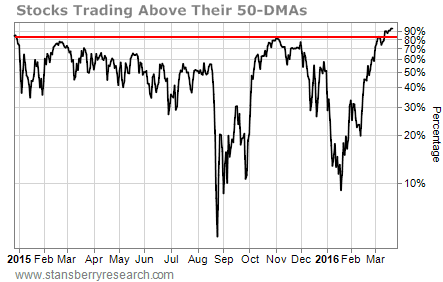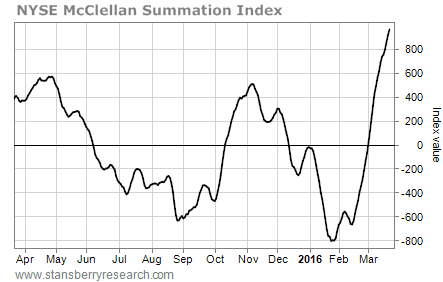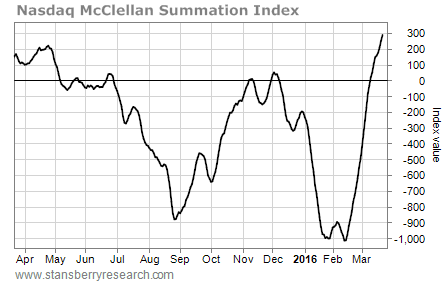The stock market looks dangerous.
By Jeff Clark, Growth Stock Wire:
There are so many reasons to be bearish right now, I can’t count all of them. Dozens of indicators are flashing “warning” signs. The market looks dangerous. Almost everything is pointing toward an intermediate-term decline coming soon.
And if it plays out the way it did when we had the same setup in November, stocks may give up all of the gains they’ve enjoyed over the past few weeks. So you need to be cautious right now. Here are three reasons why…
One, the S&P 500 is tracing out an identical pattern to what it did last October — just before the S&P 500 fell 5% in two weeks and 18% in three months. Take a look at the one-year chart of the S&P 500…

This entire bounce off the February lows has the exact same characteristics as the October rally. Both started from deeply oversold levels, following a sharp selloff in the stock market. They both formed dangerous “rising-wedge” patterns on the chart. And both pushed the daily momentum indicators – like the moving average convergence divergence (MACD), the relative strength index (RSI), and the full stochastics – into extreme overbought territory.
If the similarities continue, then then the stock market is likely headed for a rough period – starting soon.
The second big reason to be bearish is that the Volatility Index (“VIX”) options are pricing in a sharply higher VIX over the next month.
The Volatility Index is a measurement of fear in the marketplace. When the VIX is high and rising, investors are scared and traders are bearish. A low and declining VIX indicates strong bullish sentiment and complacency among traders. But it’s the VIX option prices that can tell traders where the VIX is headed, and by extension, where the stock market is headed. And right now, VIX options are sending traders a bearish signal.
VIX options are European-style contracts – meaning they can only be exercised on option-expiration day. This eliminates any possible “arbitrage” effect (the act of buying an option, exercising it immediately, and then selling the underlying security for a profit). So VIX options will often trade at a discount to intrinsic value.
For example, the VIX closed around 13.80 on Monday. At that level, the VIX April $15 calls are intrinsically worth $1.20. But they were being offered for only $0.50. That’s a $0.70 discount to intrinsic value.
If it existed as a regular American-style stock option, you could buy the call, exercise it, and liquidate the position all day long, picking up $70 for every contract you traded. The European-style feature prevents that from happening – because you can only exercise this contract on April’s option-expiration day.
VIX options provide terrific clues about where most traders expect the Volatility Index to be when the options expire. The current VIX option prices tell us that traders expect the index to be higher one month from now.
With the VIX at 13.80, the VIX April $14 calls – which are $0.20 out of the money – closed Monday at $3.20. The VIX April $14 puts – which have $0.20 of intrinsic value – closed at $0.20.
In other words, traders are willing to pay 16 times more to bet that the VIX will be higher by option-expiration day in April. And a higher VIX usually coincides with a falling stock market. We had a similar situation, by the way, in late October. Back then, VIX call options were trading for about six times the price of the equivalent put options.
Finally, multiple technical indicators have reached extreme overbought levels.
For example, the percentage of S&P 500 stocks trading above their 50-day moving average (“DMA”) lines has hit its highest level in about six years.

A reading of more than 80% is considered extremely overbought. This indicator closed Monday at 93.4%. (Since it is a percentage, it is almost mathematically impossible for it to go much higher.) Notice also that the current reading is higher than the level it reached in early November – just before stocks started to sell off.
The Summation Indexes for the New York Stock Exchange (NYSE) and the Nasdaq – which also measure overbought and oversold conditions – are back up in “nosebleed” territory.


Both indexes closed Monday well above the overbought levels they reached last November. They’re even higher now than they were when the stock market peaked last May.
I could go on… I could show you how the McClellan Oscillators for both the NYSE and the Nasdaq recently hit overbought extremes. I could show you how the VIX is pressing down on its lower Bollinger Band – something that usually happens just before the stock market sells off. I could post a chart of the S&P 500’s “bullish percent index,” which is overbought and trading above its high from last May. You get my point.
As I said above, the market looks dangerous right now. All signs are pointing to an intermediate-term decline coming soon. And if it plays out the same way it did when we had an identical setup in November, stocks may give up all of their gains from the past few weeks. This is not a good time to be aggressively buying stocks. In fact, it’s probably a good time to speculate on the short side. By Jeff Clark, Growth Stock Wire
Suddenly, all of the reasons refiners were profitable have vanished. Read… This Oil Sector Hasn’t Crashed Yet… But It’s About to
Enjoy reading WOLF STREET and want to support it? You can donate. I appreciate it immensely. Click on the mug to find out how:
![]()


In the same way that science has taken a back seat to corporate goals, at present it seems that market analyses, no matter how objective and accurate, are subordinate to the whims and machinations of central banks.
The indicators for a bear market have been in alignment since last summer, if not earlier. Even if a downturn (crash?) is inevitable, I respectfully submit that until there is political will to the contrary, the cabal of investors and traders lead by central bankers will delay it for years.
I have seen several negative articles on the direction of the stock market this year. More so than in the past. The latest is on Robert Kiosaki, who predicted in 2002 that the market crash would (will?) happen in 2016:
http://www.marketwatch.com/story/rich-dad-author-says-the-market-collapse-he-foresaw-in-2002-is-coming-2016-03-23
In it he says the same thing you and I are saying about the irrational market and the FED:
“The big question [whether] we do ‘QE4,’” said Kiyosaki. “If we do, the stock market will come roaring back, but it’s not rocket science. If we stop printing money, it crashes; if we print money, it goes up. But, eventually, it’s all going to come down.”
So the “cabal of investors and traders lead by the central bankers” may indeed delay the inevitable crash.
But crash it will. When is anybody’s guess, dependent on the whimsical machinations of the FED.
Place your bets ladies and gentlemen! The financial casino is in full swing!
“Crash it will”…
Then there’s only one thing that matters – one’s investment/speculation timeframe. Lately, what with the manipulation- and volatility-induced short-termism prevalent everywhere, every rally has ended in quick selloffs followed by panic-buying.
I submit we have to have a longer – and unleveraged – timeframe than that.
And you could add that Valeant- briefly the most valuable company in Canada with a share price of 350 has crashed to 35 or so and may now go bust owing 30 billion.
And that just before its last 50% drop- 21 of 23 analysts had buy calls, raising, parenthetically, the question of whether the whole ‘analyst’ profession is a hoax. (During its heyday, phrenology was taught at Harvard Medical.)
And that Valeant’s gouging of customers has alerted some folks in government to whole big pharma scam.
BTW: Merck has the most aggressive accounting, its EPS would be much lower under GAAP.
Very few analysts are contrarian, in fact, many have conflict of interest as their employers often underwrite the IPO etc. Many are also pseudo technical analysts….meaning they look at textbook technical and fundamentals only but have little idea of how to really value leadership and other traits of good companies. Listen to the conference calls. While some ask good technical questions for clarification or “color”, many are unable to generate outside the box questions that often give you a better sense if the mgt is on the level or just blinding people with financial/accounting science. Much like Jim Cramer on Bear Stearns, most don’t have a clue about anything beyond the paper numbers.
Whenever I get sad/scared about how things are, I say to myself…Junks were going Up the Yangtze during China’s most tumultuous times. Trade still happened…so what would I buy after a “correction” if I was flush? I think POT(we need potash to grow food).
Agnes, I sold all my POT Tuesday morning @ $18.50 which I’d just recently picked up at the bounce above $15. It closed yesterday @ $17.36.
I say this not to brag about being lucky/right, but because on Monday’s FarmNetNews weekly email post (which is for the northern plains):
“David Ashbridge is seeing an upturn in fertilizer prices over the past two weeks. …a pretty big jump on the price of urea. Nitrogen prices … are moving up for the spring season. Phosphate is moving up, …potash seems to keep dragging along. It doesn’t seem like they can get traction price-wise.”
Farm porn keeps one informed!
I have sold some other stocks this week, and agree that we’re going see a pullback. Good luck to all you WolfStreet readers out there.
US Wednesday trading the rejection medium term from 2050/55 on the SPX was confirmed. Currently its 2027 and in the red. 0800 NY time.
There is an interim S/r line around 2010 2005 depending when it gets there which was a resistance from the 11 -16Th on the way up to 2050/5.
These two S/R lines could form a short to medium term declining Megaphone Triangle. Current speed and trajectory put the intersection @ around 20.31 on the 24/03 NY time which in reality means Friday US trading.
There also appears to be a minor timeframe down channel at that trajectory.
I shorted it on the 22 @ 2056 and closed it @ 2048 on 23. And I shorted it again Yesterday Wed US trading @ 2053 which is still open @2027.
There is no facility for me to post the charts for it here or I would.
As long as we let the Federal Reserve Corporation “print” credit, this can go on for a very long time.
And yet during the January debacle, VIX for future months were priced lower even when the selling was pretty fierce.
I would advise caution. I am guessing ANOTHER bear trap. A Fed lackey can just step up to the gramophone and the markets will be off to the races again.
All hope for a normal market rests not on Western investors or citizens, etc, but on those refugees at the gates of Europe. Once that continent has been swamped, I am going to let loose my inner bear.
That’s not how calls work. If the underlying is 13.80 and the call is struck at 15.00, it is out of the money by 1.20. The 0.50 you are paying is for extrinsic value. A call gives you the right to buy something. Why would you pay 15 if it’s currently trading 13.80?
I think the problem with understanding his option prices is that the VIX options are not based directly on the VIX value, but on the VIX implied future value. April’s implied future is currently 17.475 – that’s why the calls appear overpriced and the puts underpriced.
They are options on futures. If you look at the numbers he’s quoting, the values make sense, but the interpretation does not. Also, a few paragraphs down he cites another example that makes more sense. I think the point he’s trying to make is the vol surface is massively skewed to the calls. Upside insurance is being sold for much more than downside.
when bearish/bullish “traders/investors” get included in the same mindset as “lawyers/lobbyist/legisTRAITORS/magisTRAITORS/govt agents/crats/enforcement thugs, I be a happier RURAL “growing-it-knowing-it prepper!
Chartists, and those who “read” chicken entrails have similar records on accuracy. Yes, the market is somewhat historically ‘overvalued’ presently. Earnings, and income growth have been lackluster. Boomers retire more, and the next (smaller gen X takes on more, while Gen Y is just ramping up. They are larger than Boomers, so as we transition towards their day, times likely will not be as good. Trouble when your dumb country is adding debt…
So, genius, what do YOU see coming down the road? Happy Talk?